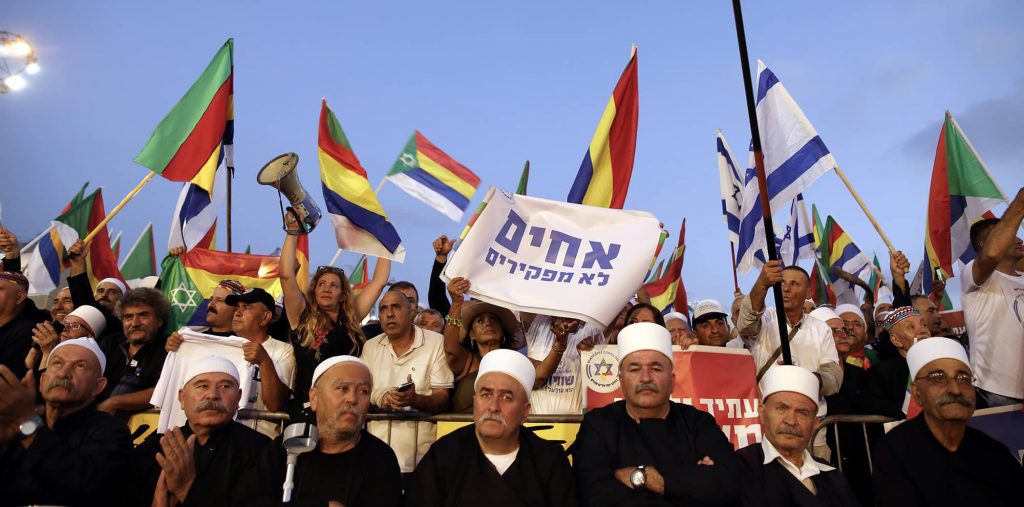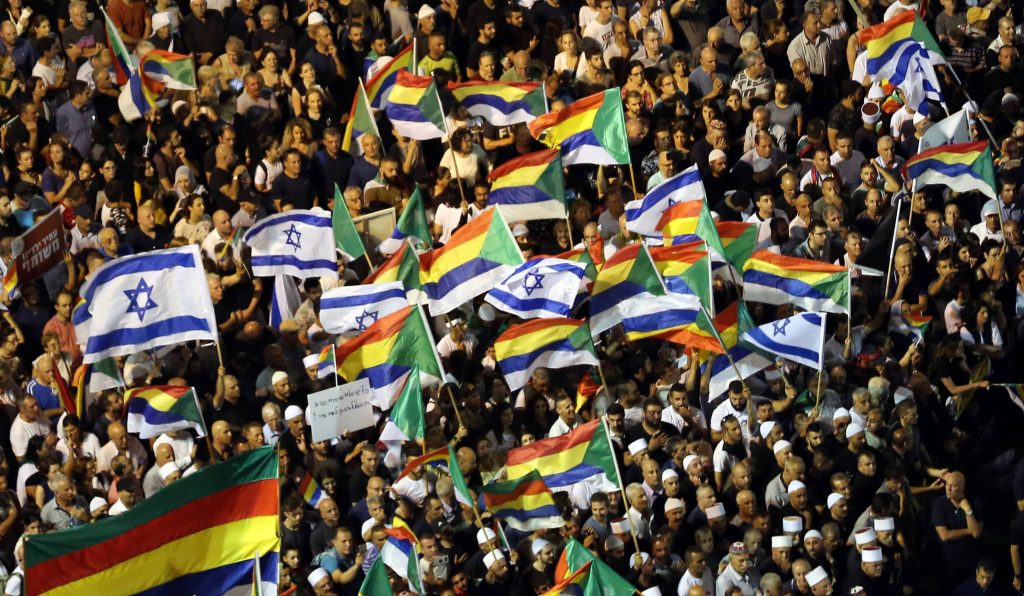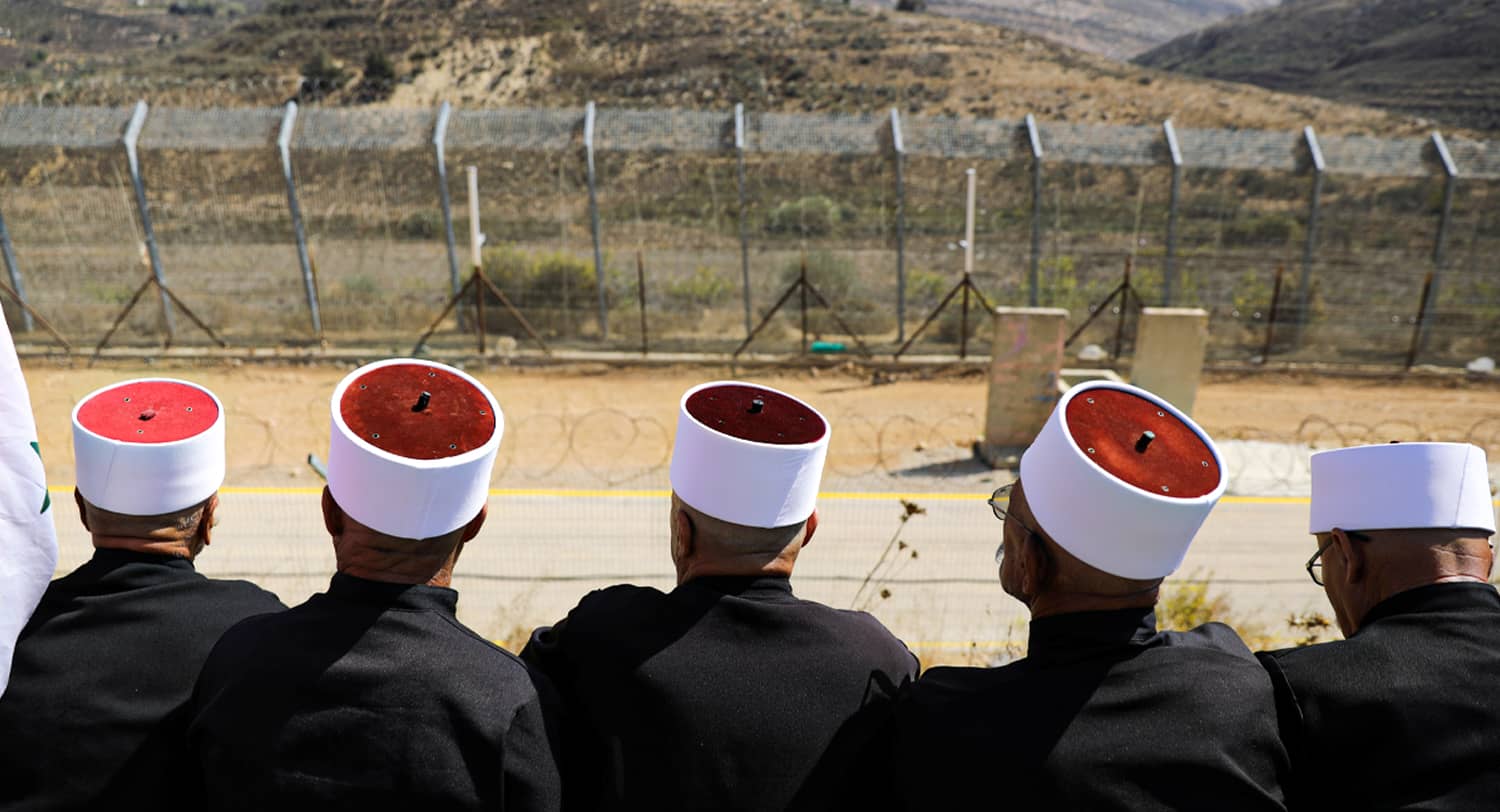Protests in Israel are nothing new, but those on the Golan Heights this June were different.
The government, as part of its clean energy program, had designated the Golan Heights for wind turbine projects. When construction began in June, the Druze on the Golan erupted in mass protests, attracting support from their coreligionists in the Galilee and Mount Carmel. Druze political and religious leaders rushed to the scene, saying the projects were encroaching on Druze lands and threatening their agrarian way of life. Israel’s Society for the Preservation of Nature also supported the protests; the Golan is a transit route for bird migration between Europe and Africa and the turbines could kill the birds.
With the Israeli press headlining the “turbine protest,” the government of Prime Minister Netanyahu put construction on temporary pause. But in the meantime, the turbines have energized what was traditionally Israel’s silent minority.
Who are the Druze?
An Arabic-speaking ethnic and religious minority group, the Druze traditionally live in mountainous parts of Syria, Lebanon, northern Israel and northern Jordan. They follow a distinct monotheistic faith, which is an offshoot of Ismaili Shi’ism, and which shares many prophets and tenets with the other Abrahamic religions. Although a small minority, they have played prominent roles in the internal politics of each country while quietly maintaining their own cultural identity in their own regions.
In Israel, the Druze community is now estimated to number 150,000, about 1.6% of Israel’s population. Dating back to the 1948 War of Independence, the mainstream of the community has a proud tradition of service in the Israeli army and identification with the state of Israel. Druze have served with distinction in both the military and civil service, with many Druze generals, ambassadors, members of Knesset and government ministers. And yet they face unresolved questions about their place in the political and social order, a reflection of broader Israeli dilemmas.
After the Six Day War of 1967, another Druze population came under Israel rule. While other Syrian residents of the Golan Heights fled when the region was taken by the IDF, the Druze remained in their four villages nestled in the foothills of Mount Hermon. Today this population of 27,000 Golan Druze has largely retained allegiance to and citizenship in Syria.
This Israeli Druze political transformation over the last decade reflects three trends. First, there is a rising awareness among Golan Druze of a future in Israel rather than in Syria, with accompanying political activism. Second, new tensions have arisen between the Druze and the state of Israel from two different laws: the nationality law which emphasizes Israel’s Jewish identity, and the Kaminitz law which seeks to centralize and enforce bans against illegal construction (a common practice in Druze villages in Israel because of the lack of authorized land for housing). Third, the “Arab Spring” which broke out in early 2011 led to a growing realization among Israel’s Druze that their community is a potential source of support for the Druze in Syria and Lebanon.
The Druze of the Golan: New Dynamics
The massive disorder over the turbine project marked a new phase in the relationship between the Golan Druze and the State of Israel.
Notably, the protests showed a closer association of the Druze in the Golan with their brethren in Israel proper, who in recent years face dilemmas of their own.
Second was growing acceptance of their place in Israel. This was a protest over a civic issue, devoid of the nationalistic overtones that used to characterize occasional bouts of pro-Syrian demonstrations by Golan Druze. Absent were any Syrian flags during the entire period of stormy demonstrations. Instead, what was visible was the five-colored flag of the Druze (red, yellow, green, blue and white) representing the higher values of the faith. This civic aspect of the protest confirms a growing trend of “instrumental integration” of the Golan Druze into Israel.
For decades after the 1967 war, the Druze community in the Golan conducted a political struggle against Israeli sovereignty and adhered to their Syrian identity. They had practical reasons – expectations that Israel would return the Golan to Syria, families and sometimes marriages among the Druze across the border in Syria, government benefits like free university education in Damascus. In exchange the Golan Druze declined Israeli citizenship, excommunicating those who did apply for it, refused to serve in the IDF, and banned the Hebrew language in their schools.
This preference, however, began to fall apart following the outbreak of the popular uprising in Syria in 2011. A new tendency emerged among the younger generation in the Golan, driven by pragmatic considerations and mirrored in similar trends among Israeli Arab citizens and Arab residents of the Jerusalem area. At its root is the desire to integrate for practical purposes into Israeli society, shown in various ways:
- As the war in Syria intensified, the number of Golan Druze who applied for Israeli citizenship rose steadily until 2016, in correlation with the deteriorating position of Asad’s regime, and then leveled off. Today, one fifth of the Golan Druze are Israeli citizens.
- There was a dramatic rise, in the decade since 2011, in the number of Golan Druze students, women and men, enrolled in Israeli universities.
- In municipal elections in the Golan in 2018, for the first time, there was some degree of participation (although the numbers were still low).
- Golan Druze businesses are increasingly working with government economic development and empowerment plans, promoted between 2014 and 2022.
- Hebrew is increasingly taught in Druze schools in the Golan, as an indication of a wish to integrate and as a necessary requirement for study in Israeli academic institutions.
In sum, although the Golan Druze continue to express solidarity with the Syrian state and nation, and do not hide their fear of radical Islamists in Syria who despise the minorities there, they increasingly accept the reality of Israeli rule, for utilitarian and instrumental reasons. Given the balance of power, locally and regionally, practical integration in Israel is seen by them as the most rational option.

Growing tensions Between the Druze in Israel and the Government
Thus, since the “turbine protest” was a civic action, not a Syrian national one, it was spontaneously joined by masses of demonstrators in Druze communities in Israel – as much because of pent-up anger among them for their own reasons as because of their identification with the Golan brethren.
Had there been a single Syrian flag raised in the Golan demonstrations, the Israeli Druze – ideologically and morally committed to loyalty to the State of Israel – would not have been able to come out in support. Moreover, as the protest focused on land use issues, it established another element of commonality.
As it happened, what drove the massive demonstrations among Israeli Druze was the sense of their own disenfranchisement and discrimination, brought about by two laws: the “Nationality Law” of 2018 perceived as giving primacy to Israel’s Jewish identity; and the “Kaminitz Law” of 2017 (named after the Deputy State Attorney) on the enforcement of construction violations. The latter led to the imposition of demolition orders and massive fines on young families. These frustrations were now channeled into support over the turbines.
Professor Amal Jamal of Tel Aviv University, who is Druze, captured the sentiment of existential crisis in a Haaretz newspaper editorial of June 26. “The Druze are facing a complex historical period. They have dedicated a lot to the relationship with the Jews, including the best of their sons, thinking that the strategic alliance with them would be beneficial for them as a small and vulnerable minority. Their frustration grew because they faced not only the closing of the prospect for equality, but also a threat to their very way of life.”
The spiritual leader of the Druze community in Israel, Sheikh Muwaffaq Tarif, sent Prime Minister Binyamin Netanyahu a letter listing four main demands: annulment of all heavy administrative fines and the freezing of legal procedures against unauthorized construction; promptly promoting master planning for Druze communities; legislation to enshrine the unique status of the Druze; and putting the turbine project on hold. He also gave a speech at a large public gathering, on June 23, sharper in tone than anything he had said in the last thirty years, railing against “unjust and racist laws,” and demanding an immediate government response.
Sheikh Tarif’s tough letter to Netanyahu was in part an attempt to defuse a leadership crisis in the community. The protests included blocking roads in the Galilee and on Mt. Carmel. For some of the protest organizers, the “turbine protest” was indeed an opportunity to pose an assertive alternative to Sheikh Tarif’s conciliatory leadership (as they see it). Hence his need to restore his authority by taking a firm stance.

The Nationality Law and the Role of the IDF Officers
In order to understand the underlying dynamics of this potential challenge, it is necessary to go back to the Druze reaction to the “Basic Law: Israel as the National State of the Jewish People” of 2018, and the role played by the Druze officers, both reservists and those still in service.
The 2018 Nationality Law set off a surprisingly intense reaction by the Druze community, including among a prominent group of IDF officers. At both the popular and the leadership level, the law was read as excluding the Druze from the core of the state, despite their contribution to Israel’s security and what came to be called the “blood pact.” The Druze fear it would erode their civic rights, and categorize them as mercenaries of the Jewish state rather than as partners in the Israeli project.
The Druze mainstream still considers partnership with the Jewish people to be a strategic choice. The Nationality Law brought into focus the anger and frustration that had already been there over other, more practical matters, in particular the construction crisis and the lack of authorized land for housing. Thus the established community leaders, who had for decades built a solid and cooperative relationship with the government, took a stand in support of the protests – while rejecting direct confrontation with the state.
The rising status of the Druze officers is especially significant. This is a group which nurtures political leaders, who often become mayors and sometimes national figures. There are also officers’ associations, with activities honoring the fallen, providing financial support for Druze students, and historically designed to promote Druze-Jewish amity as well as Druze integration in Israel.
In the last two decades, these avenues of action helped forge the former officers into a new middle class bloc which combines their background in military command, academic education and social leadership. They see themselves as agents of change – and the protest against the 2018 law was an opportunity for them to assert this role. Given their self-perceived place as a well-integrated part of the Israeli military and security elite, and given the role of this elite in Israeli life, they were all the more angered by a law that they saw as a severe blow to their Israeli identity and as a threat to their place within Israeli society. At the same time, it was also a moment for them to take charge – and in effect, challenge the traditional community leadership – speaking from a powerful position of legitimacy as former commanders in Israel’s “People’s Army.”
Clearly, this was not what the drafters of the Nationality Law intended. It was designed to affirm the Jewish People’s right to self-determination and to stand against the Palestinians’ refusal to recognize it. But for the former Druze officers this was an affront to their own identity and their reactions coincided with broader patterns of protest in Israel against the Netanyahu government (then and again now).
Both the Zionist left and the military and security elites found common cause with the Druze officers, well within the confines of the national consensus, under the Israeli flag and anthem. This also came to be reflected in voting patterns. In the series of elections between 2019 and 2022, some 90% of the Druze continued to vote for Zionist parties but shifted away from the Likud and over to the center and center-left. The officers’ political role re-emerged during the turbine crisis.

The Impact of the “Arab Spring”: the Regional Role of the Druze in Israel
At first, the uprisings in several Arab countries drew little attention among the Druze in Israel – until the outbreak in Syria in March 2011. Equanimity was replaced by growing concern by the end of 2012, as the Syrian Army was increasingly involved in large-scale fighting. The terrorist group Jabhat al-Nusra murdered seven persons in the Druze village of Khadhr in the Syrian Golan in 2013, and others in the village of Qalb al-Luza in Idlib province in 2015, followed by ISIS’s attack in 2018 on the city of al-Suwayda killing more than 250 Druze civilians. This led to Druze protests in Israel and fundraising campaigns, some led by Sheikh Tarif in person, with the money transferred to the Syrian Druze via Jordan.
Moreover, some young Druze with IDF backgrounds sought ways to volunteer to defend their brethren in Syria. This reflected real fears among all minority ethnic and religious groups in the Middle East in the face of the rise of Islamist jihadist organizations. ISIS actions – imposition of Jizyah taxes on minorities, deportation of Christians, and genocidal actions against the Yazidi minority in Iraq – raised the shadow of existential threat. The Druze reaction in Israel thus echoes the typical fears of minority groups – reminiscent of the period of “testing” (al-mihnah) in the 11th century, when the seventh Fatimid Caliph in Cairo declared a war of extermination on the Druze, accused of apostasy, which lasted seven years and led to the destruction of communities such as those in Aleppo and Antioch (in today’s Turkey).
Still, these acts of solidarity stayed within the Israeli established system. The Druze spiritual leadership under Sheik Tarif met with senior Israelis – including the Prime Minister and the Chief of Staff – to ask Israel to defend the Druze in the Syrian Golan. They also led an intense effort to persuade Russia to help provide humanitarian and other aid. At the same time, the community did remember that back in 1954, when the regime of Adib Shishakli in Damascus launched a violent military campaign against the Druze, Israel chose not to intervene, despite entreaties from the Israel Druze leadership.
The outbreak of the uprising in Syria led to growing integration – albeit instrumental – of Golan Druze into Israeli society and the abandonment of anti-Israel narratives. In parallel, it led to the popular mobilization of the Druze in Israel first in support of their brothers in Syria, and now, in authentic solidarity with the Druze protest in the Golan.
The reactions to the 2018 Nationality Law should be seen in the same light. The Druze in Israel see such legislation as a challenge to the firm relationship they have built with Israel, and as an attempt to exclude them from the public realm, causing an unprecedented crisis of confidence. But it is also a moment in which their capacity to act – within the Israeli consensus and without breaching its rules – potentially empowers them to play a role beyond their demographic weight.
By now, the “turbine protest” has demonstrated once again the intense solidarity of Druze communities across the region, reacting to perceived threats to their existence or their space. Perhaps it is a sign of the community’s ultimate integration into the somewhat fractious political culture of Israel that this solidarity is manifested in quite loud political protests.

